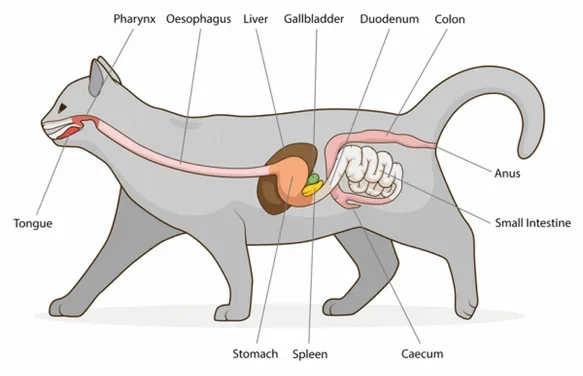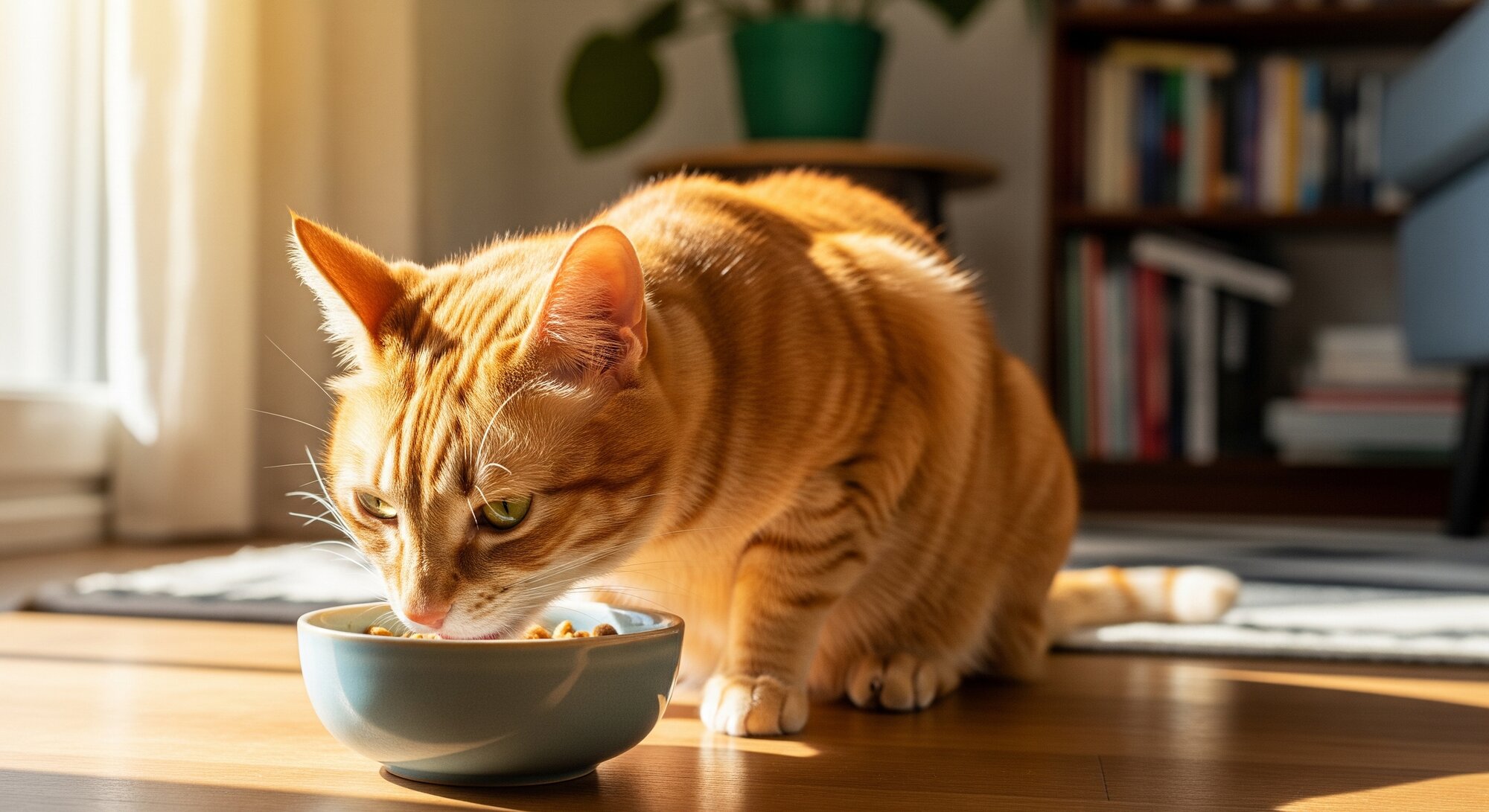Last Updated: 20/07/2025
Your Cat's Digestive System Explained
Find out how the feline digestive system works and ways that you can help maintain your cat's digestive health.
Author: Dr Teagan Lever BVSc (Hons)
Reading Time: 20 minutes - medium read
The cat's digestive tract is a complex system designed to extract and absorb nutrients from food to help fuel their many body functions. Understanding your cat's digestive system can help you to know how to support their health and well-being.
In this article we will explore the feline digestive system and how to keep it healthy, starting with pet parent's most frequently asked questions about a cat's digestive system.
How a Cat's Digestive System Works

As true carnivores, cats have a relatively short and simple digestive tract designed primarily to digest and absorb nutrients from animal based nutrients.
This differs from that of the dog who as an omnivore has a longer small intestine to facilitate digestion and absorption of nutrients from both animal and plant based foods.
Food Digestion Starts At The Mouth
Cats have sharp, pointed teeth designed to grasp, tear and slice through their food. Once the food enters the mouth it is broken into smaller pieces by the back teeth and mixed with saliva before being swallowed with the assistance of the tongue.
It is not uncommon for cats to swallow dry food whole, as their digestive tract is designed to accommodate larger chunks of food.
Pushing Food Down The Oesophagus
After swallowing, food travels down the oesophagus, a muscular tube that leads to the stomach. The muscle fibres lining the oesophagus contract in a wave like motion known as peristalsis pushing the food down to the lower oesophageal sphincter, which relaxes to allow entry to the stomach.
Digestive Enzymes Break Down Food In The Stomach
In the stomach, the ingested food is mixed with gastric juice containing digestive enzymes, hydrochloric acid and mucous.
The primary digestive enzyme secreted in the stomach of the cat is pepsin, which is responsible for breaking down proteins.
Pepsin works best in an acidic environment, which is created by the hydrochloric acid. The mucous in the gastric juice helps to protect the cells of the stomach wall from the digestive enzymes and acidic environment.
Similar to the oesophagus, the stomach contracts in peristaltic waves to help mix the gastric juice and food thoroughly.
The end result of this process is a thick milky liquid called chyme, which passes through the pyloric sphincter of the stomach into the first part of the small intestine, the duodenum.
The Duodenum Breaks Down Food Further
In the duodenum, more digestive enzymes are secreted from the intestinal wall and the pancreas to facilitate digestion of proteins, carbohydrates and fats.
Although they are carnivores, cats do secrete amylase from the pancreas and are able to digest carbohydrates and absorb their breakdown products into the blood as a source of energy.
The small intestine is where most of the nutrients are absorbed from the food. For proteins and carbohydrates, this occurs through specialised cells in the intestinal walls known as enterocytes.
Along with the enzymes released from the intestinal wall and pancreas, bile is also released from the gallbladder to help break down fats into smaller globules, ready to be absorbed into the lymphatic system before reaching the bloodstream.
Large Intestine Begins Absorbing Water
After the small intestine, the remaining undigested food reaches the large intestine, where predominantly water is absorbed.
In the large intestine, there is also some fermentation of carbohydrates and dietary fibre by beneficial bacteria. The process of fermentation produces short chain fatty acids which can be absorbed and used as a source of energy for the body.
Undigested Food Evacuated Through The Rectum
By the end of the large intestine, the faecal matter is formed, which is composed of undigested food, water and waste products produced by the body including dead cells, mucous and bacteria. The faeces then enter the rectum where they are stored before being evacuated through the external anal sphincter in the litter tray.
The digestive system is an essential part of your cat's health and well-being, providing their body with the nutrients needed to function. There are a variety of factors that can have an effect on the process, including parasites, diet, water intake and other health conditions. One simple thing you can do everyday to help maintain your cat's healthy digestion is to feed a high quality diet, particularly one designed to support optimal digestion.
Maintaining Your Cat's Digestive System Health

Problems with the digestive system can cause a variety of symptoms in cats including vomiting, regurgitation, diarrhoea and constipation. Common digestive health issues in cats include:
- Intestinal parasites
- Hairballs
- Inflammatory Bowel Disease
- Constipation caused by dehydration, pain or motility problems in the large intestine
There are a few things you can do to help keep your cat's digestive system healthy including keeping up to date with parasite control, and increasing your cat's water intake.
Supporting a healthy balance of bacteria in the gut has also been proven to help with digestive health. By feeding a diet enhanced with prebiotics including different types of fibre, you can encourage the growth of beneficial bacteria. Hill's Science Diet Feline Perfect Digestion contains Hill's exclusive blend of prebiotics, ActivBiome+, to support each pet's unique microbiome for healthy digestion and overall well-being.
Dietary fibre can also assist with hairballs by helping to move hair ingested during grooming through the digestive system.
Within the Hill's Science Diet range, there are perfectly balanced diets for kittens, adults and senior cats. All Hill's Science Diet dry foods contain clinically proven antioxidants, Vitamins C & E, for a healthy immune system.
There are also diets for specific needs including:
Top Questions about your Cat's Digestive System
A healthy gut is essential to your cat's overall well-being. Understanding their unique digestive system helps you prevent common problems like vomiting and hairballs.
Ultimately, the most significant impact you can have is through their diet. Choosing a high-quality, easily digestible food, ensuring constant access to fresh water, and maintaining regular veterinary care are the key steps to supporting your cat's digestive health, keeping them happy and active for years to come.
History
Our experts continually monitor the health and wellness space and we update our articles when new information becomes available.
Wed 17 May 2023
Written by Dr Teagan Lever BVSc (Hons)Dr Teagan Lever BVSc (Hons)
Head Veterinarian, BVSc (Hons)
Pet Circle's Head Veterinarian, Dr Teagan graduated from the University of Queensland in 2010 and went on to work in small animal and mixed practice in various locations around QLD & ACT before joining Pet Circle in early 2016. Dr Teagan has special interests in dermatology, nutrition and preventative health care. She feels privileged to witness the special bond people share with their pets on a daily basis and enjoys forming lasting relationships with pet parents and their fur children.

